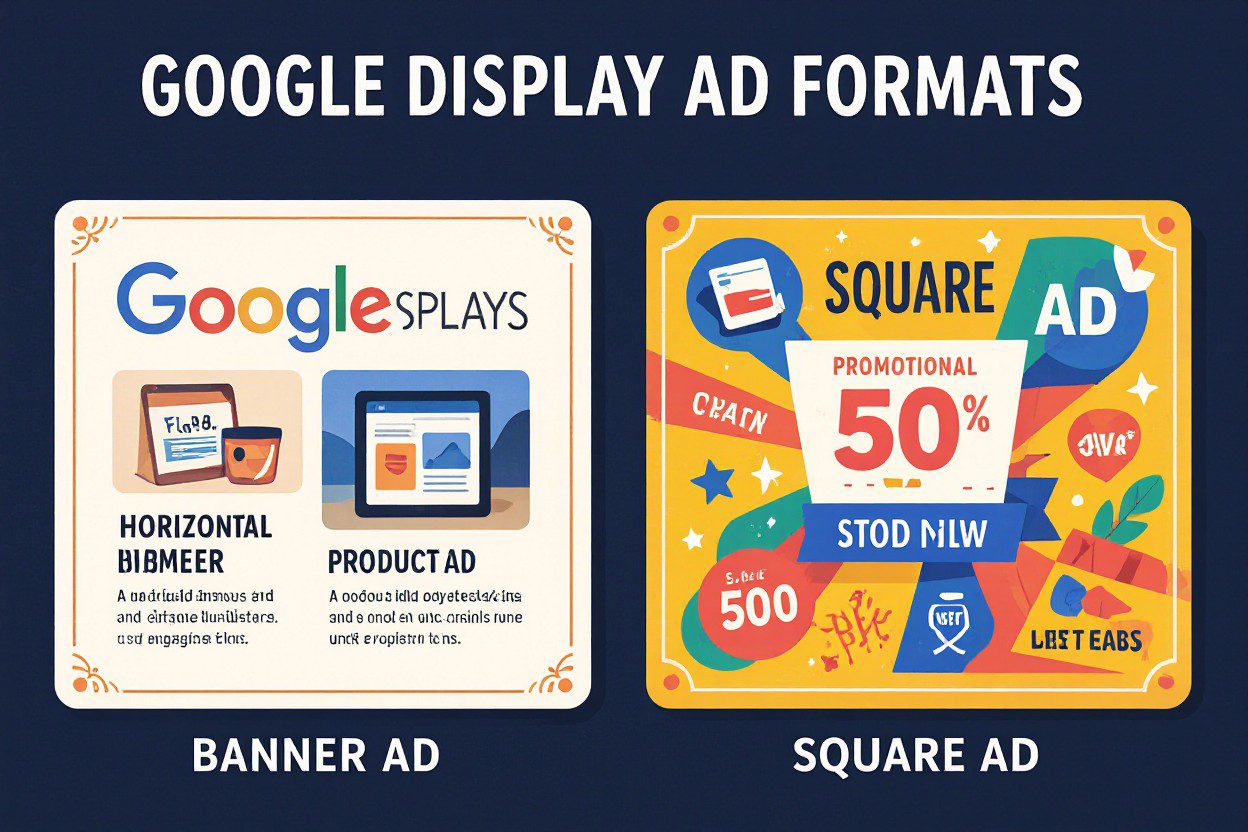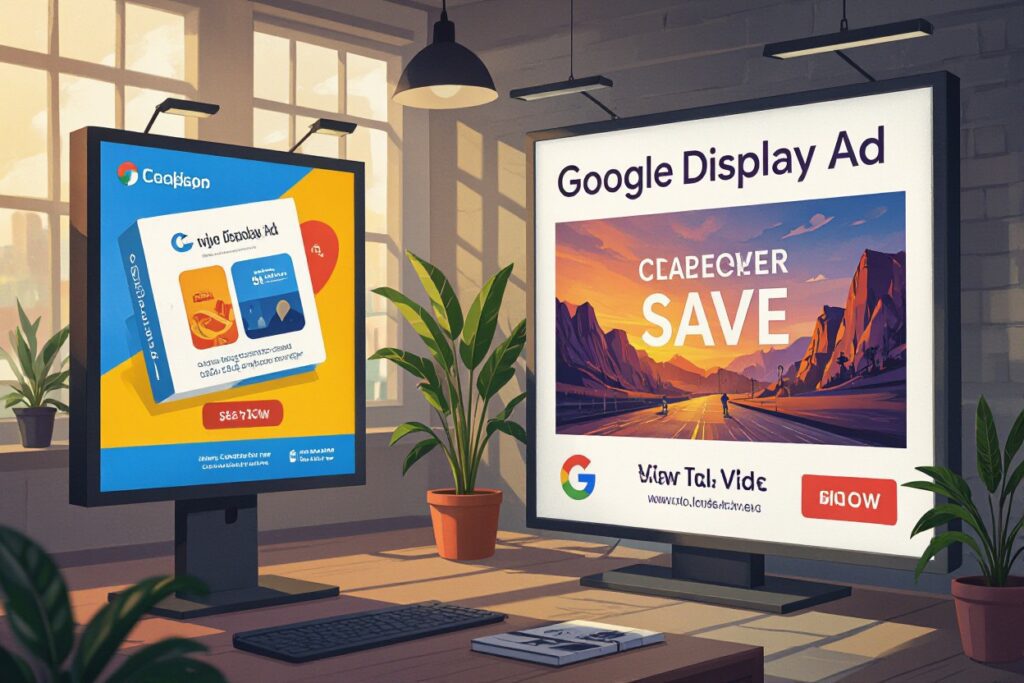Formats play a significant role in shaping the effectiveness of your Google Display Ads campaign. When I design ads, I focus on two main ad formats: responsive display ads and uploaded image ads. Each format offers unique advantages that can help you reach your target audience more effectively. By understanding and leveraging these ad formats, you can optimize your campaigns for better engagement and conversion rates, ensuring your advertising budget delivers maximum ROI.


The Visual Appeal of Image Ads
Image ads capture attention through striking visuals that quickly convey your message. They leverage colors, branding, and compelling imagery to make an immediate impact amidst the clutter of the Google Display Network. High-quality images paired with concise text guide viewers toward your call to action, boosting engagement and brand recall. Through well-crafted image ads, you can create an emotional connection with your audience, increasing both click-through rates and conversions.
Components of Effective Image Ads
Effective image ads balance eye-catching visuals with clear messaging. A strong headline, a relevant high-resolution image, and a concise call-to-action button prioritize simplicity and relevance. Including your logo ensures brand recognition, while contrast and color choices direct the viewer’s focus. Designs that adapt seamlessly across various device sizes help maintain visibility and drive clicks regardless of where your audience encounters your ads.
Best Practices for Designing Image Ads
Optimizing image ads involves maintaining consistent branding, using bold colors that stand out, and ensuring text readability at any size. Testing multiple versions to identify which visuals and messages perform best leads to continuous improvement. I often recommend focusing on simplicity—avoiding clutter allows the core message to shine. Incorporating tools like Google’s responsive ad format can also automate scaling, saving time while maximizing reach.
Beyond general design guidelines, leveraging platform-specific recommendations enhances ad effectiveness. For instance, Google recommends using a 1.91:1 aspect ratio for most image ads, which fits well across both desktop and mobile devices. Using fewer than 20% text ensures better ad approval rates and increases viewer engagement. Employing brand colors consistently helps in building immediate recognition, while subtle animations or .gif formats sometimes boost interaction, but should be tested carefully to avoid distraction. Experimenting with these elements can significantly elevate your campaign’s performance on the Display Network.
The Dynamic Engagement of Responsive Ads
Responsive ads utilize machine learning to automatically adjust size, appearance, and format to fit various ad spaces across the Google Display Network. This adaptability means your campaigns can deliver consistent messaging with optimized visuals on websites, mobile apps, and even Gmail. I’ve seen brands increase their ad reach by 30% simply by switching to responsive ads, thanks to the ability to serve personalized creatives tailored to user environments. This flexibility removes the hassle of designing multiple image ads and lets you focus more on creative messaging while Google’s algorithms optimize delivery in real-time.
How Responsive Ads Adapt to Different Platforms
Responsive ads dynamically resize and reformat themselves based on the platform and device they appear on, whether desktop, tablet, or smartphone. For example, they might display as a large banner on desktop but convert seamlessly into a native ad on mobile apps. By automatically mixing text headlines, descriptions, images, and logos, responsive ads create combinations that fit each platform’s unique requirements and maximize visual engagement. This ensures your ad looks polished everywhere without extra work on your end.
Measuring Success with Responsive Ads
Performance metrics for responsive ads give you clear insights into which ad components perform best across different placements, informing future creative decisions. You can track click-through rates, conversion data, and impressions segmented by asset type—like image versus headline—providing a granular view of what resonates. I often analyze these reports to refine headlines and imagery, boosting CTR by up to 15% in some campaigns.
Diving deeper into measurement, Google Ads’ asset reports show detailed statistics per creative asset, exposing which images or text variations drive engagement. This granular feedback allows you to pause underperforming elements while scaling those that work, optimizing budget allocation efficiently. Additionally, A/B testing multiple responsive ad sets combined with Google’s automated optimization provides reliable data on how design or copy changes impact overall campaign performance, enabling continuous improvement over time.
Comparing Image and Responsive Ads: Which is Right for You?
| Image Ads | Responsive Ads |
|---|---|
| Static or animated visuals, designed specifically with precise dimensions. Requires manual creation but offers total creative control. | Automatically adjust size, appearance, and format based on available ad space. Flexibility minimizes management and broadens reach across devices. |
| Best suited for strong brand visuals or campaigns with stringent creative guidelines. | Ideal for testing multiple creatives and headlines without constant manual updates, leveraging Google’s machine learning. |
| Usually demands additional design resources and compliance with format specs to ensure quality display. | Offers ease of use and efficiency, especially for campaigns targeting diverse demographics and platform types. |
Target Audience Considerations
If your campaign targets a niche market or a limited demographic, image ads can provide the specific stylistic impact needed to resonate deeply. For broader audiences spanning various devices or regions with diverse browsing habits, responsive ads allow your campaign to adapt seamlessly, ensuring your message reaches viewers with optimized formats tailored to their environment.
Campaign Goals and Objectives
Clarity around your primary goals—whether brand awareness, lead generation, or direct conversions—shapes your choice of ad format. Image ads deliver polished visuals that enhance brand recall, making them better for awareness-driven campaigns. Responsive ads can optimize for conversions by dynamically testing multiple creative combinations, raising the chance of engaging users who respond to different messaging or design elements.
Digging deeper, responsive ads leverage Google’s machine learning to identify top-performing creatives on the fly, reallocating impressions toward those versions. This dynamic approach can accelerate reaching performance goals without constant manual oversight. Conversely, if control over exact visual presentation or messaging tone aligns more with your strategy, investing in professionally crafted image ads can solidify brand positioning and differentiation in competitive markets.
Optimizing Your Google Display Ads Campaign
Maximizing the impact of your Google Display Ads requires a keen eye for detail and ongoing refinement. Adjusting bids, targeting options, and ad placements based on campaign data helps fine-tune who sees your ads and when. Incorporating feedback from real-time performance allows you to reduce wasted spend and increase engagement rates. Leveraging audience insights to tailor creatives can also significantly boost your campaign’s effectiveness, turning impressions into meaningful interactions.
A/B Testing Ad Formats
Running A/B tests between responsive ads and uploaded image ads lets you identify which format resonates more with your target audience. For instance, testing two variations of an ad with different visuals or headlines across the same demographic can reveal which drives higher click-through rates. Switching between static banners and rich media also uncovers preferences for interactivity versus simplicity. These experiments help pinpoint the optimal creative treatment and format mixture that maximizes conversions.
Analyzing Performance Metrics for Improvement
Examining key metrics such as click-through rate (CTR), conversion rate, and cost per acquisition (CPA) provides insight into which ad formats and placements deliver value. Low CTR might suggest the need for more compelling visuals or clearer messaging, while a high CPA could indicate inefficient targeting or bidding strategies. Tracking impression share can expose lost opportunities due to budget limits or ad rank, guiding adjustments to recapture audience segments. Utilizing Google Analytics in tandem with Google Ads data gives a more holistic view of user behavior and ROI.
Diving deeper into these metrics, segmenting data by device type or demographics often reveals trends that guide further customization. For example, a campaign might perform better on mobile devices with shorter, more direct ad copy. Heatmaps and viewability reports highlight which ad positions garner the most attention, allowing budget reallocation toward premium sites or placements. Leveraging automated rules to pause underperforming ads or adjust bids based on performance thresholds can dynamically enhance efficiency without requiring constant manual oversight.
Future Trends in Google Display Advertising
Google Display Ads continue evolving to match shifting user behaviors and technological advances. As advertisers, watching emerging trends allows you to anticipate changes and adjust strategies proactively. Innovations like AI-driven creation tools and evolving ad formats promise greater personalization and engagement, reshaping how your campaigns perform on the Display Network.
The Rise of AI in Ad Creation
AI-powered tools now analyze vast data sets to craft highly tailored ads that resonate with specific audience segments. By automating creative optimizations and dynamically generating ad variations, these tools help you increase relevance and click-through rates. Recent studies show AI-generated ads can boost conversion rates by up to 30% compared to manually created content.
Predictions for Evolving Ad Formats
Next-generation ad formats will likely blend immersive experiences with interactive elements, expanding beyond static or simple video ads. Features like augmented reality overlays and personalized mini-games embedded within display ads are on the horizon, designed to capture eyeballs and encourage deeper engagement.
Looking ahead, Google’s emphasis on richer storytelling through formats such as interactive HTML5 ads will transform user interaction. Advertisers might soon integrate real-time data triggers for hyper-contextual messaging, making ads feel less intrusive and more like organic content. Such changes could redefine what we expect from display campaigns, pushing creativity and technology to new heights.
Conclusion
On the whole, I understand that the two main ad formats you can use in a Google Display Ads campaign are responsive display ads and uploaded image ads. Responsive display ads automatically adjust their size, appearance, and format to fit available ad spaces, making them flexible and easy to use. Uploaded image ads, on the other hand, give you full control over your creative design but require specific sizes and formats. Choosing the right format depends on your campaign goals and creative resources, enabling you to effectively reach your target audience across the Google Display Network.

